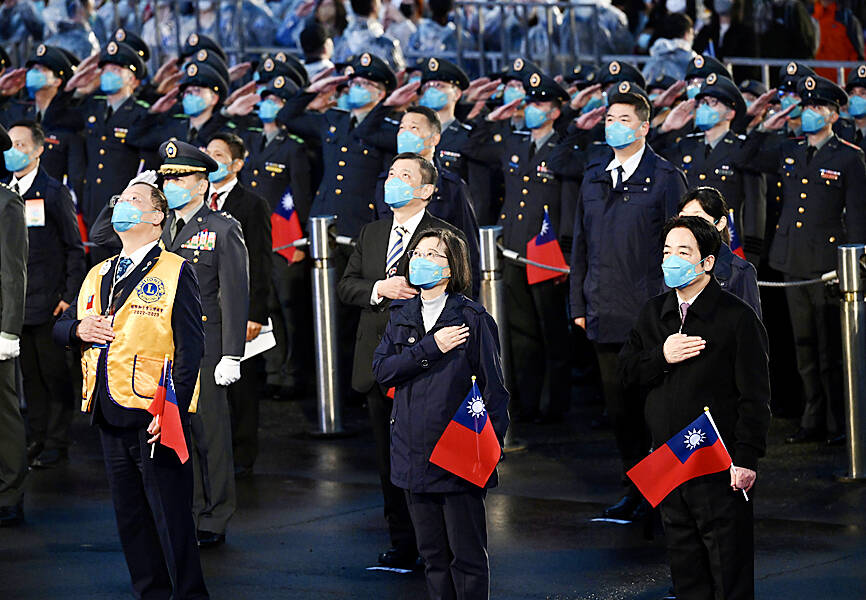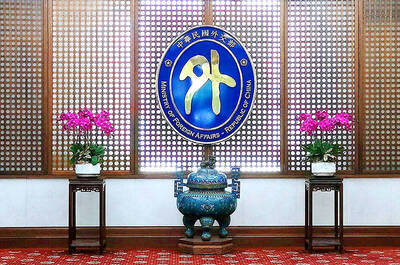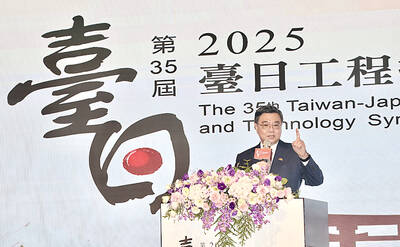Surplus national tax revenue is to be used to close financing gaps in the Labor Insurance and National Health Insurance funds, subsidize electricity prices and fund a series of initiatives to help weather potential dramatic changes in global economy this year, President Tsai Ing-wen (蔡英文) said in her New Year address at the Presidential Office in Taipei yesterday.
“We will consider sharing excess tax revenue with all citizens only when it is within our fiscal capacity to do so,” Tsai said.
Lawmakers from the Democratic Progressive Party and Chinese Nationalist Party (KMT) have urged the government to return the surplus tax revenue to the public.

Photo courtesy of the Association of Taipei Photojournalists
“I understand that some have proposed that excess tax revenue be equally shared among our people, which would surely make everybody happy,” Tsai said.
“However, as a responsible government, we need to plan ahead when the global economy is fraught with a high level of uncertainty,” she said. “We should prioritize the distribution of valuable resources to individuals and industries at risk to maintain the resilience of the country in times of crisis.”
“This is not an easy decision, but we must do it for our country. We hope that people understand and support this decision,” she added.
The Ministry of Finance estimated that last year’s national tax revenue is expected to exceed the budget by NT$450 billion (US$14.65 million), of which NT$70 billion is to be used to fund the operations of local governments, Tsai said.
Of the remaining NT$380 billion in tax revenue, NT$100 billion is to be allocated to electricity price subsidies and closing the funding gap in the Labor Insurance and National Health Insurance funds, she said.
Another NT$100 billion is to be used to fund government initiatives to withstand potential global economic changes this year, she said.
The initiatives include increasing the housing supply and offering subsidies for renters and those who are on home loans; subsidizing public transport commuters; subsidizing families who are in the middle and low-income range; reinforcing agricultural and fishery infrastructure; attracting 6 million international tourists this year; sustaining stable prices of food and daily necessities; and helping upgrade small and medium-sized industries nationwide, she said, citing decisions made at a National Security Council meeting on Saturday.
Whether this means the government is unlikely to distribute cash or vouchers using the remaining surplus tax revenue as it did in 2020 and last year, Tsai said that closing the financing gap of the Labor Insurance Fund and maintaining stable retail prices are also ways to return tax revenue to the public.
The global economy is likely to be worse than expected this year, and there remains a high level of uncertainty, she said.
“The rest of the tax revenue — NT$180 billion — could enable us to fund subsequent economic stimulus plans. We need to use the money cautiously in case emergency situations occur,” she said.
Tsai said the Presidential Office and the Executive Yuan are together consulting the private sector on the development of six core strategic industries: national defense, war readiness, precision healthcare, renewable energy, cybersecurity, and semiconductor and information technology.
Stability of the Indo-Pacific region is also threatened, she said.
A plan she introduced last week to bolster national defense would enhance Taiwan’s defense through a comprehensive adjustment of the defense systems and by raising the quality and quantity of military training for conscripts, she said.

The Ministry of Foreign Affairs (MOFA) yesterday voiced dissatisfaction with the Comprehensive and Progressive Agreement for Trans- Pacific Partnership (CPTPP), whose latest meeting, concluded earlier the same day, appeared not to address the country’s application. In a statement, MOFA said the CPTPP commission had "once again failed to fairly process Taiwan’s application," attributing the inaction to the bloc’s "succumbing to political pressure," without elaborating. Taiwan submitted its CPTPP application under the name "Separate Customs Territory of Taiwan, Penghu, Kinmen and Matsu" on Sept. 22, 2021 -- less than a week after China

ALIGNED THINKING: Taiwan and Japan have a mutual interest in trade, culture and engineering, and can work together for stability, Cho Jung-tai said Taiwan and Japan are two like-minded countries willing to work together to form a “safety barrier” in the Indo-Pacific region, Premier Cho Jung-tai (卓榮泰) yesterday said at the opening ceremony of the 35th Taiwan-Japan Modern Engineering and Technology Symposium in Taipei. Taiwan and Japan are close geographically and closer emotionally, he added. Citing the overflowing of a barrier lake in the Mataian River (馬太鞍溪) in September, Cho said the submersible water level sensors given by Japan during the disaster helped Taiwan monitor the lake’s water levels more accurately. Japan also provided a lot of vaccines early in the outbreak of the COVID-19 pandemic,

A home-style restaurant opened by a Taiwanese woman in Quezon City in Metro Manila has been featured in the first-ever Michelin Guide honoring exceptional restaurants in the Philippines. The restaurant, Fong Wei Wu (豐味屋), was one of 74 eateries to receive a “Michelin Selected” honor in the guide, while one restaurant received two Michelin stars, eight received one star and 25 were awarded a “Bib Gourmand.” The guide, which was limited to restaurants in Metro Manila and Cebu, was published on Oct. 30. In an interview, Feng Wei Wu’s owner and chef, Linda, said that as a restaurateur in her 60s, receiving an

Kaohsiung Mayor Chen Chi-mai (陳其邁) on Monday announced light shows and themed traffic lights to welcome fans of South Korean pop group Twice to the port city. The group is to play Kaohsiung on Saturday as part of its “This Is For” world tour. It would be the group’s first performance in Taiwan since its debut 10 years ago. The all-female group consists of five South Koreans, three Japanese and Tainan’s Chou Tzu-yu (周子瑜), the first Taiwan-born and raised member of a South Korean girl group. To promote the group’s arrival, the city has been holding a series of events, including a pop-up